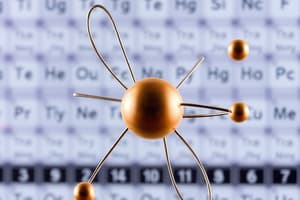Podcast
Questions and Answers
What is electron configuration?
What is electron configuration?
Electron configuration describes the arrangement of electrons around the nucleus of an atom.
Explain the Aufbau principle in electron configuration.
Explain the Aufbau principle in electron configuration.
The Aufbau principle states that electrons fill the lowest energy levels first.
How are the shells of an atom numbered in electron configuration?
How are the shells of an atom numbered in electron configuration?
The shells are numbered as 1, 2, 3, 4, and so on.
What is the electron configuration for Boron (Atomic number 5)?
What is the electron configuration for Boron (Atomic number 5)?
How many electrons can the first shell of an atom accommodate?
How many electrons can the first shell of an atom accommodate?
Explain the trend in atomic number as we move across the periodic table.
Explain the trend in atomic number as we move across the periodic table.
Describe the pattern of shell filling in electron configuration.
Describe the pattern of shell filling in electron configuration.
How does atomic size change as we progress through the periodic table?
How does atomic size change as we progress through the periodic table?
Why is understanding electron configuration vital in comprehending the structure of an atom?
Why is understanding electron configuration vital in comprehending the structure of an atom?
How does mastering electron configuration deepen our understanding of the physical world?
How does mastering electron configuration deepen our understanding of the physical world?
Flashcards are hidden until you start studying
Study Notes
Understanding the intricate design of an atom is crucial to our comprehension of the physical world. In this article, we'll dive into the structure of an atom and explore its fundamental components, starting with the concept of electron configuration.
Atomic Structure
An atom is the smallest unit of any element that can exist independently. It's made up of three components:
- Protons: Positively charged particles found in the nucleus.
- Neutrons: Neutral particles found in the nucleus.
- Electrons: Charged particles that orbit the nucleus in shells or energy levels.
Electron Configuration
Electron configuration describes the arrangement of electrons around the nucleus of an atom. It's represented by a set of notation that tells us which energy levels (or shells) are occupied and how many electrons are in each shell.
The shells are numbered as 1, 2, 3, 4, and so on, with the first shell representing the innermost orbit and containing the lowest energy electrons. Each shell can accommodate a certain number of electrons based on the principle of Aufbau (building up) principle, which states that electrons will fill the lowest energy levels first.
Here's a brief overview of the electron configuration for the first 20 elements:
- Hydrogen (1 proton, 1 electron): 1s¹
- Helium (2 protons, 2 electrons): 1s²
- Lithium (3 protons, 3 electrons): 1s² 2s¹
- Beryllium (4 protons, 4 electrons): 1s² 2s²
- Boron (5 protons, 5 electrons): 1s² 2s² 2p¹
- Carbon (6 protons, 6 electrons): 1s² 2s² 2p²
- Nitrogen (7 protons, 7 electrons): 1s² 2s² 2p³
- Oxygen (8 protons, 8 electrons): 1s² 2s² 2p⁴
- Fluorine (9 protons, 9 electrons): 1s² 2s² 2p⁵
- Neon (10 protons, 10 electrons): 1s² 2s² 2p⁶
- Sodium (11 protons, 11 electrons): 1s² 2s² 2p⁶ 3s¹
- Magnesium (12 protons, 12 electrons): 1s² 2s² 2p⁶ 3s²
- Aluminum (13 protons, 13 electrons): 1s² 2s² 2p⁶ 3s² 3p¹
- Silicon (14 protons, 14 electrons): 1s² 2s² 2p⁶ 3s² 3p²
- Phosphorus (15 protons, 15 electrons): 1s² 2s² 2p⁶ 3s² 3p³
- Sbphorus (16 protons, 16 electrons): 1s² 2s² 2p⁶ 3s² 3p⁴ 3d¹
- Chlorine (17 protons, 17 electrons): 1s² 2s² 2p⁶ 3s² 3p⁵
- Argon (18 protons, 18 electrons): 1s² 2s² 2p⁶ 3s² 3p⁶
- Potassium (19 protons, 19 electrons): 1s² 2s² 2p⁶ 3s² 3p⁶ 4s¹
- Calcium (20 protons, 20 electrons): 1s² 2s² 2p⁶ 3s² 3p⁶ 4s²
Periodic Trends in Electron Configuration
As we progress through the periodic table, several trends in electron configuration become apparent:
- Atomic number: The number of electrons in the outermost shell (also known as valence electrons) increases.
- Shell filling: The electron configuration follows a pattern of filling the shells from lowest to highest energy level.
- Atomic size: As the atomic number increases, the atomic radius grows larger, leading to a decrease in nuclear charge experienced by the valence electrons.
Understanding electron configuration is a vital part of comprehending the structure of an atom. This knowledge is essential for predicting chemical properties, bonding behavior, and the periodic trends observed in the periodic table. By mastering electron configuration, we can delve deeper into the behavior of the elements and their interactions, leading to a deeper understanding of the physical world.
Studying That Suits You
Use AI to generate personalized quizzes and flashcards to suit your learning preferences.




